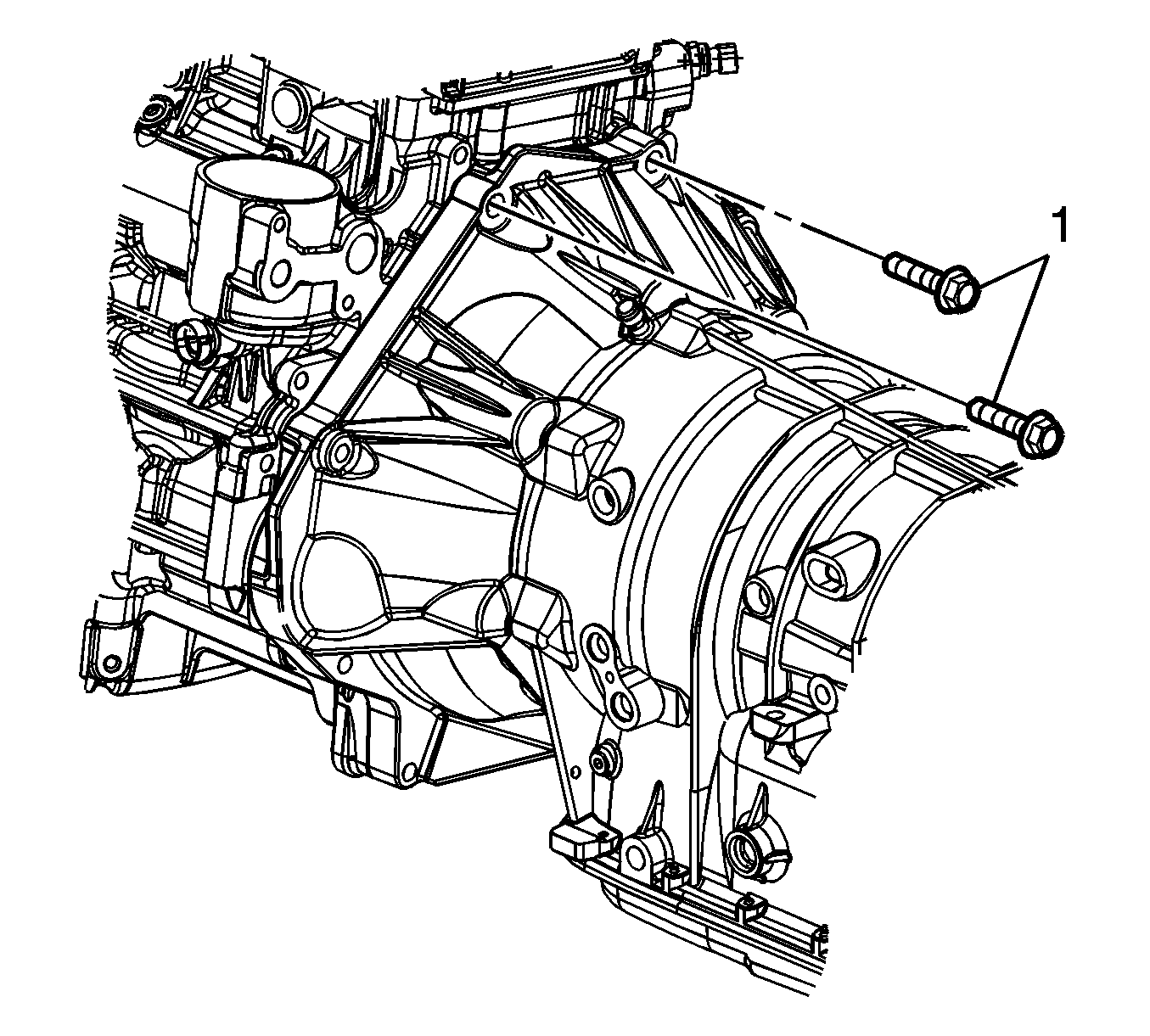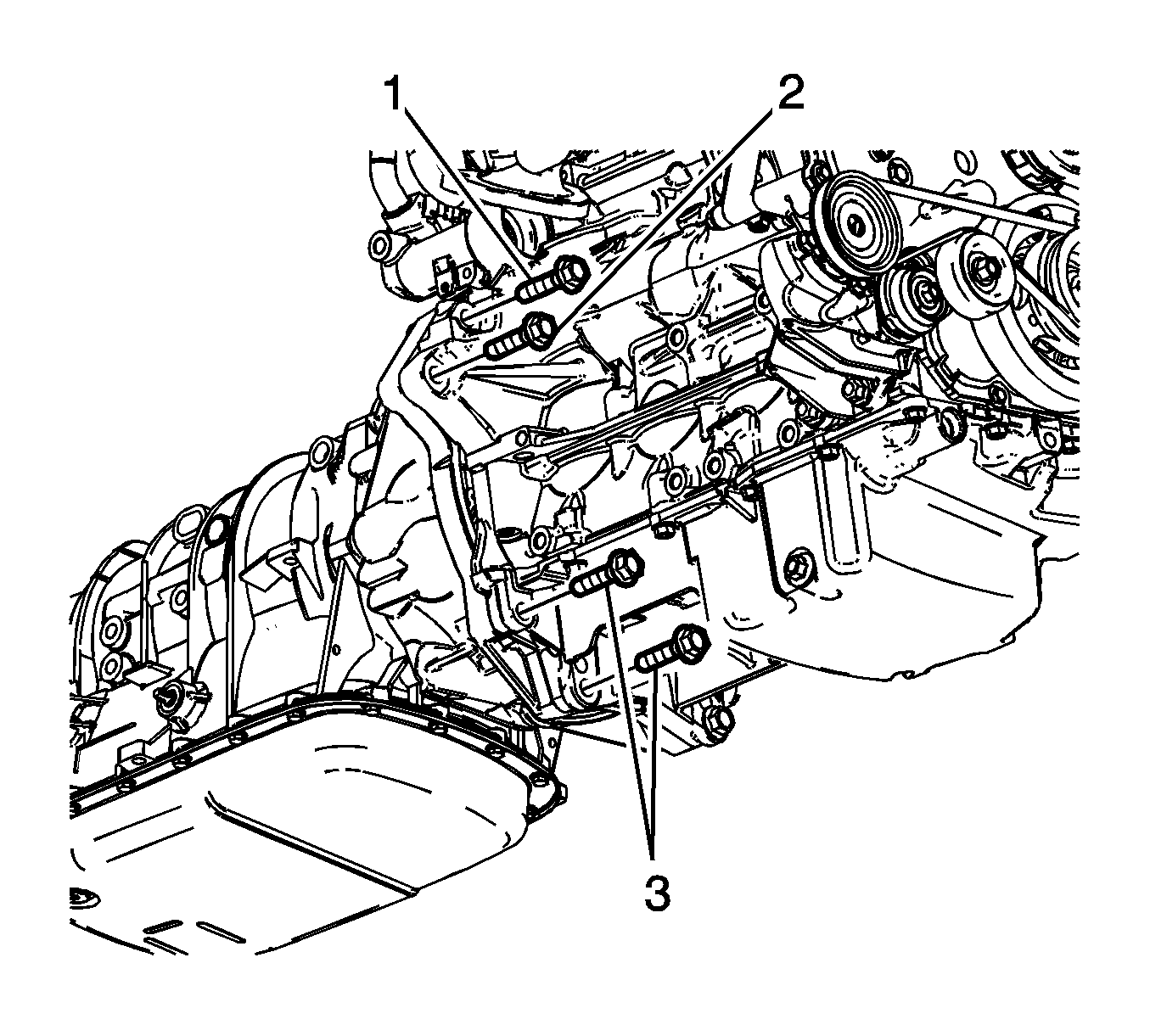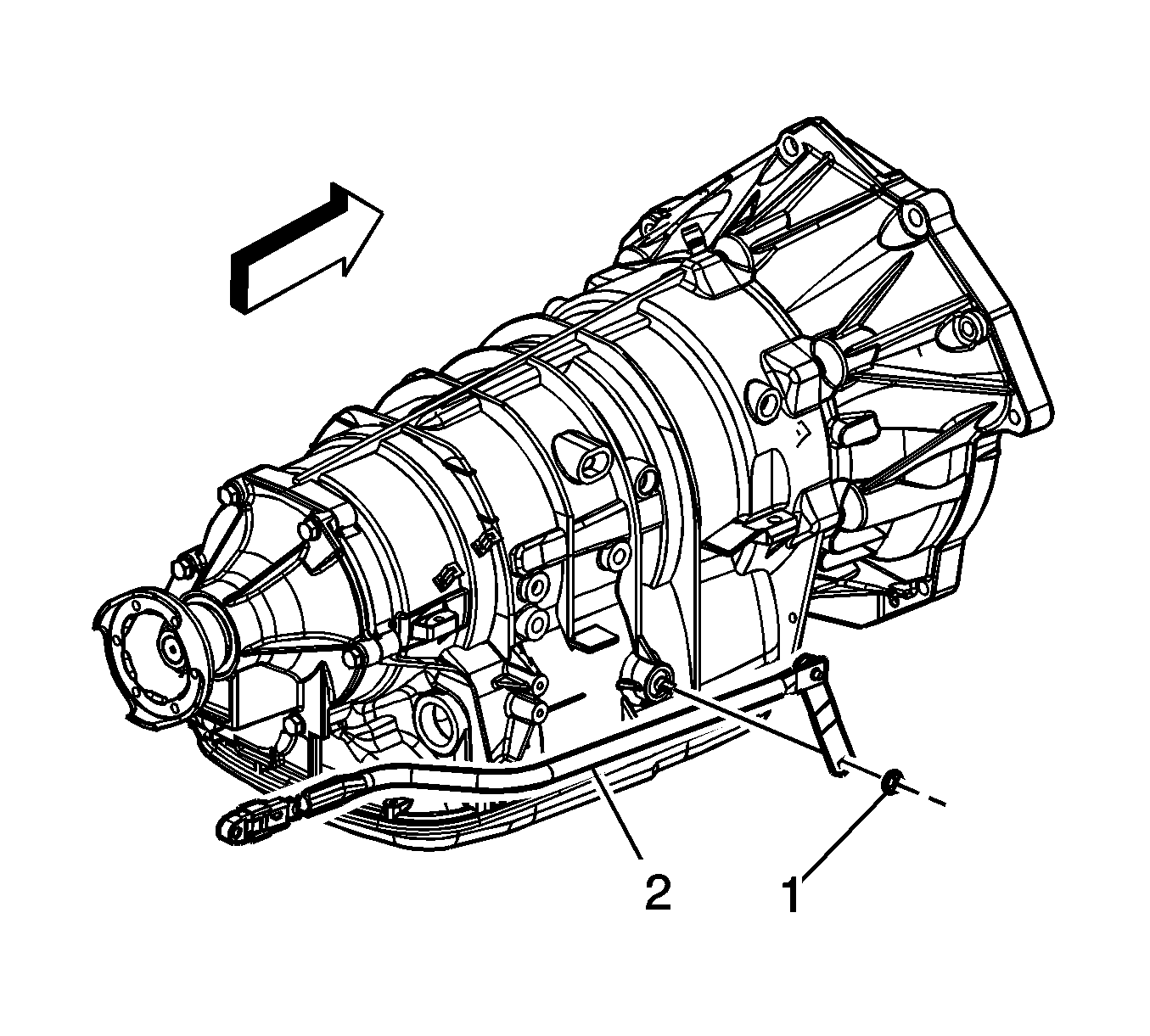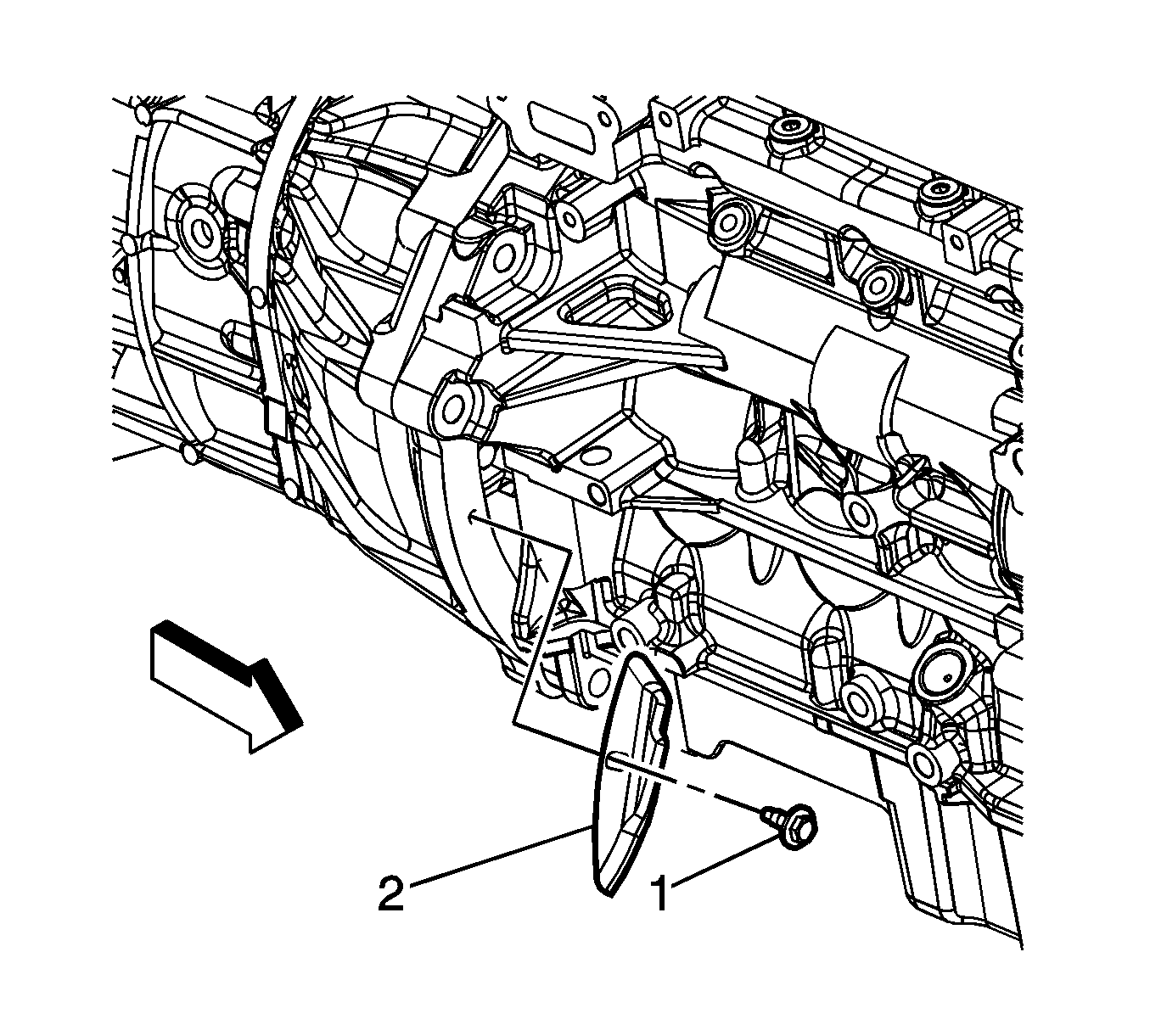For 1990-2009 cars only
Removal Procedure
- Disconnect the negative battery cable. Refer to Battery Negative Cable Disconnection and Connection.
- Remove the starter motor to gain access to the torque converter bolts. Refer to Starter Motor Replacement.
- Remove the left side transmission to engine mounting bolt (2).
- Remove the two upper transmission mounting bolts (1).
- Remove the turbocharger, If equipped. Refer to Turbocharger Replacement.
- Remove the right side transmission to engine mounting bolts (1, 2).
- Raise and support the vehicle. Refer to Lifting and Jacking the Vehicle.
- Remove the front closeout panel. Refer to Floor Panel Tunnel Panel Replacement - Front.
- Drain the transmission fluid if disassembly of the transmission is necessary. Refer to Automatic Transmission Fluid and Filter Replacement.
- Remove the transmission manual shift shaft nut (1).
- Disconnect the shift linkage (2) from the transmission.
- Place the transmission in Neutral by rotating the transmission shift shaft clockwise 2 clicks.
- Remove the propeller shaft. Refer to Propeller Shaft Replacement.
- Disconnect the transmission wiring harness connector (4) from the transmission by rotating the locking latch counterclockwise.
- Disconnect the wiring harness clips (1-3) from the transmission, and position the wiring harness aside.
- Remove the flywheel inspection cover bolt (1) and cover (2).
- Mark the torque converter to flexplate/flywheel orientation to ensure proper realignment.
- Repeat the following steps for all 3 torque converter bolts:
- Place an oil drain pan under the transmission fluid cooler pipes.
- Remove the bolt (1) securing the transmission fluid cooler pipes retainer (2) to the transmission.
- Remove the transmission fluid cooler pipes from the transmission, and position aside.
- Remove the O-rings. Do not reuse the O-rings.
- Plug the open outlet ports to prevent fluid loss and contamination.
- Position a suitable transmission jack under the transmission.
- Remove the transmission mount. Refer to Transmission Rear Mount Replacement.
- Remove the left side transmission to engine mounting bolts (1).
- Remove the right side transmission to engine mounting bolts (3).
- Pull the transmission free from the engine dowels.
- Carefully lower the transmission from the vehicle.
- Flush the transmission oil cooler. Refer to Transmission Fluid Cooler Flushing and Flow Test.
- If the transmission is being replaced, remove the drive flange and install it on the replacement unit. Refer to Drive Flange and Seal Replacement.
Note: NEW torque converter bolts will be required each time the torque converter bolts are removed.






| 18.1. | Rotate the harmonic balancer center bolt clockwise ONLY, in order to align the torque converter bolt with the starter motor opening in the engine block. |
| 18.2. | Remove and discard the torque converter bolt. The bolt is self locking and is NOT reusable. |



Installation Procedure
- Using the transmission jack, carefully raise the transmission to the vehicle.
- Align the transmission with the engine dowels.
- Install the right transmission mounting bolts (3) and tighten to 50 N·m (37 lb ft).
- Install the left transmission mounting bolts (1) and tighten to 50 N·m (37 lb ft).
- Install the transmission mount. Refer to Transmission Rear Mount Replacement.
- Remove transmission jack from under the transmission.
- Place NEW seals over the transmission fluid cooler pipes.
- Insert the transmission fluid cooler pipes into the transmission.
- Install the bolt (1) securing the transmission fluid cooler pipe retainer (2) to the transmission and tighten to 25 N·m (18 lb ft).
- Align the torque converter to flexplate/flywheel orientation marks made during the removal procedure.
- Repeat the following steps for all 3 torque converter bolts:
- Install the flywheel inspection cover (2) and bolt (1).
- Connect the wiring harness clips (1-3) to the transmission.
- Connect the transmission wiring harness connector (4) to the transmission by rotating the locking latch clockwise.
- Install the propeller shaft. Refer to Propeller Shaft Replacement.
- Place the transmission in the park position by rotating the shift shaft fully counterclockwise.
- Connect the shift linkage (2) to the transmission.
- Install the transmission manual shift shaft nut (1) and tighten to 9 N·m (80 lb in).
- Check the transmission fluid level (fill if necessary). Refer to Transmission Fluid Check.
- Adjust the shift control linkage. Refer to Shift Control Linkage Adjustment.
- Install the front closeout panel. Refer to Floor Panel Tunnel Panel Replacement - Front.
- Lower the vehicle.
- Install the right transmission mounting bolts (1, 2) and tighten to 50 N·m (37 lb ft).
- Install the turbocharger, If equipped. Refer to Turbocharger Replacement.
- Install the two upper transmission mounting bolts (1) and tighten to 50 N·m (37 lb ft).
- Install the left transmission mounting bolt (2) and tighten to 50 N·m (37 lb ft).
- Install the starter motor. Refer to Starter Motor Replacement.
- Connect the negative battery cable. Refer to Battery Negative Cable Disconnection and Connection.
- The transmission control module must be programmed with the proper software/calibrations.
Caution: Refer to Fastener Caution in the Preface section.



Note: Torque converter bolts are self locking and must be replaced with NEW torque converter bolts every time the bolts are removed.
| 11.1. | Rotate the harmonic balancer center bolt clockwise ONLY, in order to align the torque converter bolt holes in the flexplate/flywheel with the starter motor opening in the engine block. |
| 11.2. | To aid in alignment of the torque converter to the flexplate/flywheel. Install all 3 NEW torque converter bolts before fully tightening. Tighten the bolts to 63 N·m (46 lb ft). |






Transmission Final Test and Inspection
Complete the following procedure after the transmission is installed in the vehicle:
- With the ignition OFF or disconnected, crank the engine several times. Listen for any unusual noises or evidence that any parts are binding.
- Start the engine and listen for abnormal conditions.
- While the engine continues to idle raise and support the vehicle. Refer to Lifting and Jacking the Vehicle.
- Inspect for fluid leaks while the engine is idling.
- Lower the vehicle.
- Perform a final inspection for the proper fluid level.
- Reset the TAP values. Refer to Transmission Adaptive Functions.
- Road test the vehicle.
Note: It is recommended that transmission adaptive pressure (TAP) information be reset.
Resetting the TAP values using a scan tool will erase all learned values in all cells. As a result, the engine control module (ECM), powertrain control module (PCM), or transmission control module (TCM) will need to relearn TAP values. Transmission performance may be affected as new TAP values are learned.